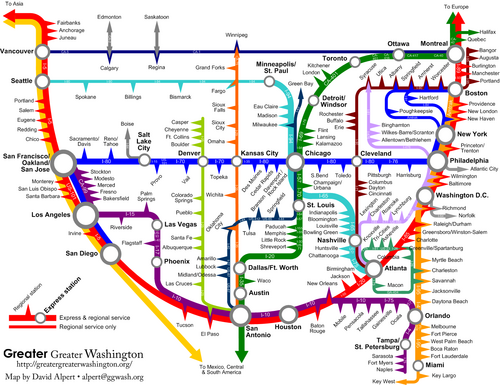Sci-fi coast to coast high speed rail network
Imagine that long-distance, very high speed rail lines (airplane speeds or better) were practical and relatively cheap to build. What might the resulting transit-like intercity service look like?
Working on the recent DC fantasy maps reminded me of this map which I created years ago. Here it is, dusted off for your pleasure. Click on the map for a larger version.
More notes and comments below.
I envisioned three types of service: international, express, and regional. Regional service would stop at all of the stops, while express would hit only the express stops (the circles). There may also be local service stopping at even more locations along the routes.
International service would cross national boundaries, stopping in the express stations along the route in special customs-controlled areas. The national express and regional services would turn back at a border instead; for example, the green express and regional services would run from San Antonio to the US-controlled portion of the Detroit/Windsor station complex (located somewhere near the border) and with a connection to the Canadian service that continues north; meanwhile, the green international service would run from South and Central America and Mexico to Europe with stops at the express stations in the U.S. and Canada.
Looking at this map now, I can definitely see lots of smaller cities that I left off. It’s not meant to be exhaustive; this map only shows the major regional and national routes. There would probably be additional local stops and smaller regional lines.
Some lines would run extra service on part of the line; I could see extra frequencies in the Ohio portion of the maroon line or the Colorado portion of the lime line. Thin lines aren’t necessarily less important, just shorter and/or not lines that connect several major cities.
In the major cities, this map shows one primary station. This would be a transfer point (perhaps located at the site of the now-unused airport?) from the intercity lines to a network of local lines that connect the transfer station to various parts of the metro area, and from one part of the metro area to another. The local lines may also reach the adjacent stations; for example, Washington DC’s local lines would reach at least as far as Baltimore (as they do today) and Richmond.

